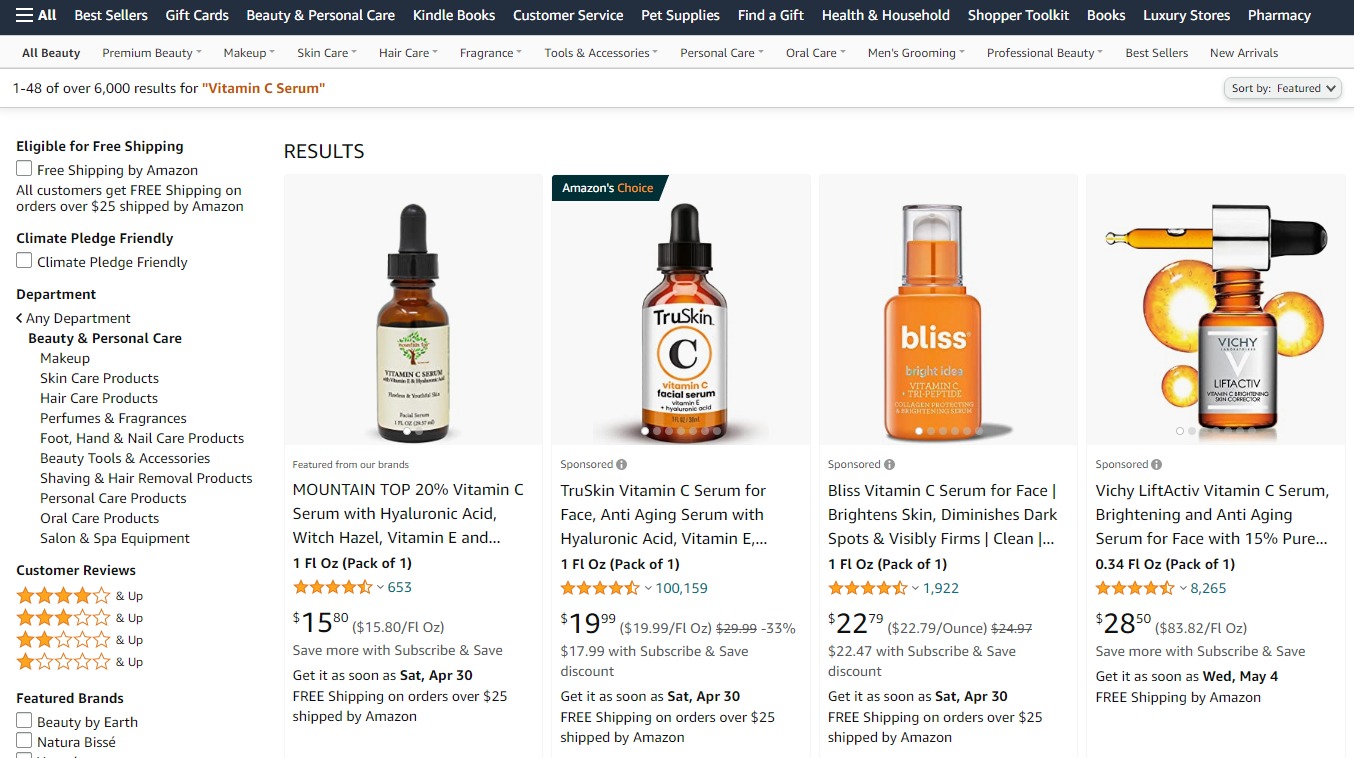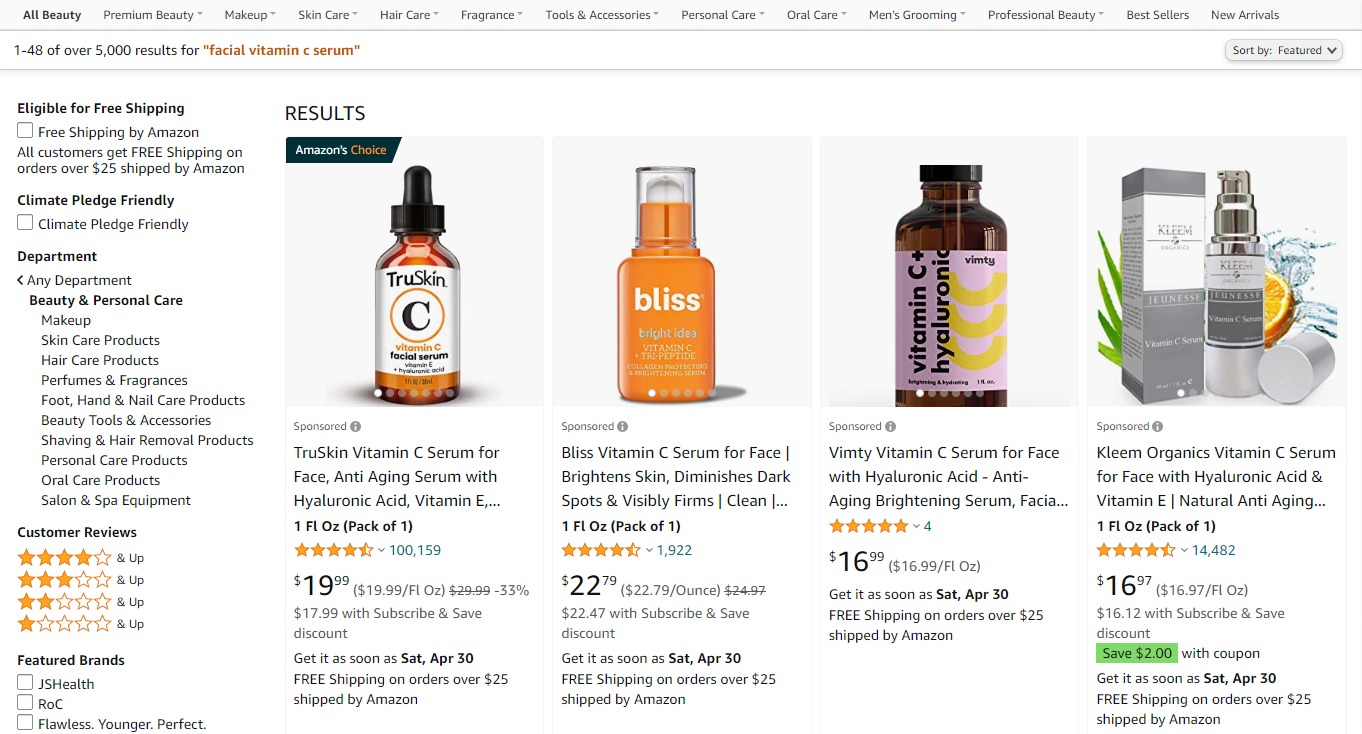The method for researching product opportunities is a multi-step process of identifying products with a high Best Seller Rank, via the top 100 best seller lists, and sizing up the competition via keyword searches and rankings.
This guide will focus on explaining the differences between Best Seller Ranking vs Keyword Ranking
Best Seller Rank Explained
Amazon maintains one or more Best Seller Ranks (BSR) for each product it sells. The BSR ( Best Seller Rank ) that interests is the one for the Top Category, not the sub-categories.
The reason you should care about BSR is because it is an indicator of how well a type of product sells.
Anything in the Top 100 Bestsellers list for any major (top level) category sells extremely well. You can see all the best seller top level categories on the left sidebar on this page: https://www.amazon.com/gp/bestsellers/
These are the “Top Level” categories. For example: Appliances, Baby, Beauty, and Electronics, to name just a few on that list.
If you click on any of the links, you will see the 2nd level categories (or sub-categories) for that Top level category. For example, if you click on Appliances, you will see:
Here they are: Built-In Dishwashers , Countertop Dishwashers , Portable Dishwashers
Amazon categories can get many levels deep
As you click through the sub-categories of the Best Sellers lists, Amazon gives you the top 100 products for that sub-category.
When you look at a product listing, you will usually see the BSR of that product in the top level category as well as a BSR for the sub-category it is listed in. They may even give you the BSR for a couple of sub-categories.
However, You should only focus on the top level category BSR.
Let’s explore why.
Let’s say we wanted to evaluate the best selling car in the US. The best seller top level category might be called “Cars.”
Cars would have a sub-category for each make of car. One might be Mercedes, another might be Honda, another might be Ford, etc.
Now, in the Mercedes Category we might have a Category for Sedans, and another for SUVs.
Under Sedans, we might have a C-Class sub category, and under C-Class we might have a 500-Series sub-category and in there would have a C550 Sedan.
So it might all look something like this as we walk down the sub-categories:
Cars |===> Mercedes |===>Sedans |===> C-Class |===> 500-Series
When you consider that Amazon has almost 1.5 million unique products available for purchase in the Beauty category alone, you can see that the BSR for that product in a deep sub-category is meaningless because the deeper you go, the less competition there is as there are fewer products, just as the deeper we got within the Mercedes example to the point where the C550 was the only car in it’s deepest category.
It’s easy to be number 1 when you are the only one, right? 🙂
How Best Seller Rank Is Calculated
The Best Seller Rank (BSR) for a product is calculated continuously by Amazon and therefore it can change throughout the day.
The product that sells the most number of units for a specific category receives the BSR of 1 and shows up first in the Best Seller list for that category, the product with the second most number of units sold receives BSR of 2 and shows up second for that category, and so forth.
It does not matter that the BSR is changing all the time, because as you will see below, the BSR is only used to give us an idea of how well a product sells.
How and Why Use the BSR
As stated earlier, BSR use to help us determine how well a specific type of product sells (units per day).
Although we cannot know for sure how many units of any given product sell on any given day, we can qualify like this: any product in the top 100 bestsellers list for a top level category sells a LOT of units per day. Yes, a WHOLE LOT! 🙂
Unfortunately, Amazon only gives us the top 100 products for any given category, but we can tell even a product with a BSR of 500 in a top level category sells very well.
There is no real way of knowing unless you actually have a product that has a BSR of about that number in that category and so you can see the results yourself.
Therefore, you should search the Top 100 Bestsellers for each top-level category, which is a really safe bet a product sells well.
Note: If you start digging through the sub-categories, you will start finding products with BSRs of 101+ for the top-level category, and we believe that anything with a BSR of 1-500 in the top level category can be safely assumed to be selling very well.
The Type of Product Versus the Specific Product
The BSR number can see as for a specific product. This means a specific brand and/or model of that type of product.
In this case, a specific listing for Vitamin C Serum. Even though there are many other Vitamin C Serums listed for sale on Amazon, it is that specific one which is selling well enough to earn a BSR of 22 in the Beauty category.
Not all Vitamin C Serums are selling as well as these are.
In fact, this may or may not be the product you are going to compete with on Amazon and you do not need to have the highest BSR for that product type to sell well and make a lot of money.
To understand this, you first need to review the concept of keyword rankings.
Keyword Rankings on Amazon
While it is great to look at the Bestsellers lists for the purposes of doing research and understanding what sells well, consumers do not purchase products using the Bestseller lists.
Instead, customers find and purchase products by doing keyword searches.
The second step in the process of finding a product opportunity is to then figure out the highly searched keywords that people might use for while looking for your type of product.
for example, let’s say “vitamin c serum” is the primary keyword for our sample product.
Meaning the highest number of searches will be done using that keyword. In the world of SEO this would be incredibly difficult to compete for and you would try away from it. Instead, you must find “easier” keywords, or “long-tail” keywords that were less competitive.
In the world of Amazon, you want THE most competitive keywords period! Yes, that’s right. You will rank for THE most competitive keywords.
So your job is to try and find the best and most commonly used keywords in order to continue opportunity analysis.
we won’t cover keyword research in this document, Instead we will focus on what keyword rankings mean in comparison to BSR.
How Products Rank for Keywords
You already saw that the BSR ranking is directly related to how many units per day a product sells. Keyword rankings on the other hand are based on two things:
1. How relevant a product is for that keyword: optimize your listing for your top level keywords
2. How well your product sells after a buyer searches for a specific keyword, finds your product, and buys.
This is also referred to as your conversion rate, and Amazon tracks this on a per keyword basis.
Now that you understand this, can you see that for a given keyword, a product that has a better BSR ranking may rank lower in the search results than a product that has a worse BSR rank?
For example, when we search for “Vitamin C Serum” the product we found with a BSR of 22 is actually the top listed product.
However, when we search for “facial vitamin c serum” it is the 3rd product on the page, while the first product listed on that page has a BSR of 4635 in beauty.
So… how can a product with a BSR of 4635 beat a product that has a BSR of 22?
This is exactly the concept you need to understand… it is also the most “tricky one” because at first glance it does not make any sense… but with a little bit of help you will see the difference and you will understand clearly…
When a customer does a keyword search, Amazon wants to give that customer the best results possible.
The most relevant results that will result in a purchase, so they can make money. In order to do this, they will search their database for the best possible match for that keyword and for the product that sells most often when other customers have search that exact keyword.
Using these two pieces of information, their algorithm gives each product a score and returns the search results in a specific order, with the most likely candidate at the top and the second best candidate next, and so on.
In this example, this means that the product with a BSR of 4635 was better optimized and converted better than the product with a BSR of 22 for the keyword search of “facial vitamin c serum.”
While the product with a BSR of 22 was better optimized and converted better for the search “vitamin c serum.”
Let’s keep looking further at the same example. For the keyword “vitamin c serum” here are the BSRs of the top 10 results in order:
1. BSR = 22
2. BSR = 614
3. BSR = 157
4. BSR = 293
5. BSR = 3006
6. BSR = 2151
7. BSR = 4635
8. BSR = 2339
9. BSR = 354
10. BSR = 6373
It just so happens that for the keyword “vitamin c serum” the product with the best BSR also ranks the highest for the keyword, but this is not always the case, and you can see this as you go down the list above.
They do not show up in BSR order! So now that we know a particular type of product sells well, and we know how to look at how products rank for keyword searches, all that is left is to look at the competition.
Sizing Up the Competition
Once you find a hot selling product by looking at the Bestsellers lists, you will figure out the highest traffic keywords and search those.
You will then look at the listings and evaluate how well optimized these listing are for that keyword you are searching.
One additional item you want to look at is number of reviews for those products in the search rankings, but you do not pay too much attention to this. however If every single product in top 10 had thousands of reviews then you should be concerned.
Beating the Competition
your focus should be on getting ranked for specific keywords and the rest will happen automatically. Remember how Amazon determines your rank for specific keyword searches?
1. How well optimized your listing is for that particular keyword. Example: Is the exact keyword in the title?
2. How well does your product convert for that keyword search. Meaning, what percentage of people searching for that keyword end up buying your product?
Well, the first item is super easy, right? Just make sure the keywords you want to rank for are in the title and also in your listing description, etc.
How about the second? Could there be a way to improve our conversion stats for a particular keyword? 🙂
Check more relevant Articles:
How To Get Amazon Book Reviews
Amazon Associate Program For Beginners
10 Best Amazon FBA Course ( Six-Figure Business )
5 Steps To Start Amazon FBA Business : Make Passive Income
Consider Following a Course ?
With Lifetime Access ?
We have been the number 1# platform for delivering most demanding course. Becoming Lifetime Member , You will receive all the Premium content For FREE

Consider Following a Course ? With Lifetime Access ?
We have been the number 1# platform for delivering most demanding course. Becoming Lifetime Member , You will receive all the Premium content For FREE





